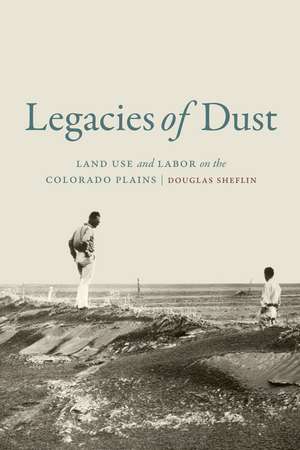Legacies of Dust: Land Use and Labor on the Colorado Plains
Autor Douglas Sheflinen Limba Engleză Paperback – 31 iul 2021
2020 Center for the Study of the American West (CSAW) Award for Outstanding Western Book Finalist
The Dust Bowl of the 1930s was the worst ecological disaster in American history. When the rains stopped and the land dried up, farmers and agricultural laborers on the southeastern Colorado plains were forced to adapt to new realities. The severity of the drought coupled with the economic devastation of the Great Depression compelled farmers and government officials to combine their efforts to achieve one primary goal: keep farmers farming on the Colorado plains.
In Legacies of Dust Douglas Sheflin offers an innovative and provocative look at how a natural disaster can dramatically influence every facet of human life. Focusing on the period from 1929 to 1962, Sheflin presents the disaster in a new light by evaluating its impact on both agricultural production and the people who fueled it, demonstrating how the Dust Bowl fractured Colorado’s established system of agricultural labor. Federal support, combined with local initiative, instituted a broad conservation regime that facilitated production and helped thousands of farmers sustain themselves during the difficult 1930s and again during the drought of the 1950s. Drawing from western, environmental, transnational, and labor history, Sheflin investigates how the catastrophe of the Dust Bowl and its complex consequences transformed the southeastern Colorado agricultural economy.
| Toate formatele și edițiile | Preț | Express |
|---|---|---|
| Paperback (1) | 225.57 lei 6-8 săpt. | |
| Nebraska – 31 iul 2021 | 225.57 lei 6-8 săpt. | |
| Hardback (1) | 403.43 lei 6-8 săpt. | |
| Nebraska – 31 mai 2019 | 403.43 lei 6-8 săpt. |
Preț: 225.57 lei
Nou
Puncte Express: 338
Preț estimativ în valută:
43.16€ • 44.53$ • 36.02£
43.16€ • 44.53$ • 36.02£
Carte tipărită la comandă
Livrare economică 26 martie-09 aprilie
Preluare comenzi: 021 569.72.76
Specificații
ISBN-13: 9781496224996
ISBN-10: 149622499X
Pagini: 426
Ilustrații: 21 photographs, 1 illustration, 4 maps, 2 tables, index
Dimensiuni: 152 x 229 x 29 mm
Greutate: 0.62 kg
Editura: Nebraska
Colecția University of Nebraska Press
Locul publicării:United States
ISBN-10: 149622499X
Pagini: 426
Ilustrații: 21 photographs, 1 illustration, 4 maps, 2 tables, index
Dimensiuni: 152 x 229 x 29 mm
Greutate: 0.62 kg
Editura: Nebraska
Colecția University of Nebraska Press
Locul publicării:United States
Notă biografică
Douglas Sheflin is an instructor of history at Colorado State University.
Cuprins
List of Illustrations
Acknowledgments
Introduction: The Dust and Everything After
1. Early Lessons from the Land of Opportunity
2. The County Agents Take Root
3. Dirt
4. Claiming the Arkansas
5. On the Move
6. Food for Victory
7. An Unquenchable Thirst
8. Back to Work
Conclusion: There and Back Again?
Notes
Bibliography
Index
Acknowledgments
Introduction: The Dust and Everything After
1. Early Lessons from the Land of Opportunity
2. The County Agents Take Root
3. Dirt
4. Claiming the Arkansas
5. On the Move
6. Food for Victory
7. An Unquenchable Thirst
8. Back to Work
Conclusion: There and Back Again?
Notes
Bibliography
Index
Recenzii
"The discussion of the environment and migrant labor in the decades after the Dust Bowl distinguishes this volume from others on the subject and broadens its importance beyond the regional."—C. K. Piehl, Choice
"Sheflin has written a perceptive, smart, and solidly researched history that informs us about the Colorado Dust Bowl. . . . It is a transformative story of the federal government’s influence on the agriculture, demography, politics, and labor of the region."—R. Douglas Hurt, Journal of Arizona History
"A highly informative study for students of agricultural history."—Lynn Bueling, Roundup Magazine
“Legacies of Dust offers a significant new interpretation of the Dust Bowl. Douglas Sheflin’s long-term analysis of the Dust Bowl’s impact is this book’s most distinctive and important contribution. And his investigation of the direct and indirect impacts of the Dust Bowl and the New Deal on the agricultural labor force in the 1930s, 1940s, and 1950s is especially pathbreaking.”—Brian Q. Cannon, professor of history and director of the Charles Redd Center for Western Studies at Brigham Young University
“While both popular and scholarly accounts of the Dust Bowl confine it to the 1930s, this careful and authoritative reconstruction of southeastern Colorado provides a much longer time frame for assessing two pivotal processes of the 1940s and 1950s: how farmers adopted a new and largely effective set of soil and water conservation practices and how the region came to depend on a labor regime of migratory workers. Sheflin deftly threads an analysis of the Dirty Thirties together with the broadest questions of postwar agricultural history.”—Sarah T. Phillips, associate professor of history and director of graduate studies at Boston University
“This is a serious and thoughtful history of Colorado agriculture. The way it mixes environmental, political, and labor history is always interesting and sometimes downright poetic. The material on migrant children is important and absolutely fascinating.”—Jonathan Rees, professor of history at Colorado State University at Pueblo
“Douglas Sheflin’s new, exceptionally well-researched study of the legacy of New Deal, Dust Bowl policies in southeast Colorado, convincingly reveals how the combined work of the Colorado Extension Service, the Social Conservation Service, the Production Management Administration, and Soil Conservation Districts rectified the unsustainable production-first mentality of farmers in the 1920s. As a result, Sheflin clearly illustrates how these policies produced for farmers a federal safety net well beyond the 1930s, especially for those who practiced soil conservation.”—James E. Sherow, University Distinguished Professor at Kansas State University
Descriere
Focusing on the period from 1929 to 1962, this study examines how the catastrophe of the Dust Bowl and its complex consequences transformed the southeastern Colorado agricultural economy.
